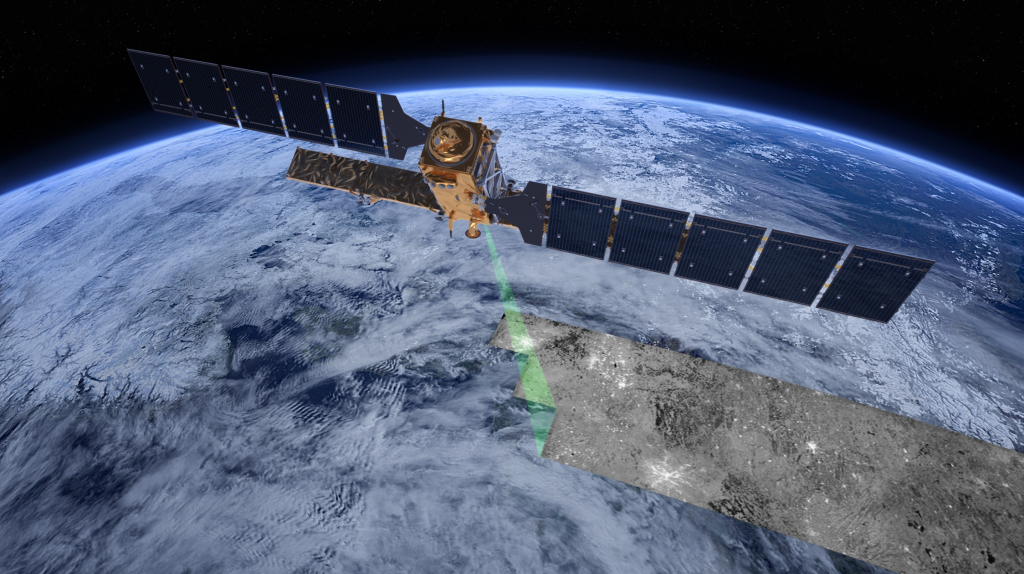Satellites are like Earth’s external hard drives, continuously saving enormous volumes of data about our planet’s surface, atmosphere, and even beyond. As of May 2023, about 7,702 active satellites were orbiting our Earth being used for various applications (Ieva, 2023). This data, when processed and analyzed, can reveal patterns that are highly valuable for scientific, environmental, commercial, and security applications. With the huge amount of satellite data, how do we efficiently convert this raw data into actionable insights? Here is where artificial intelligence steps in and plays a key role.
The role of AI in satellite data analysis

First, Artificial intelligence comes into play with crunching the huge amount of data that is being produced by satellites. To put this amount into perspective, solely from the two earth observation NASA missions SWOT and NISAR, 100 terabytes of data daily is expected to be generated. Just a single terabyte can hold the data equivalent to about 250 full-length films (Greicius, 2023). Thanks to AI the data can be quickly processed and can be used as an input for decision-making.
Secondly, another aspect where AI can assist is data augmentation. Satellite imagery often is recorded when atmospheric conditions are not ideal. Clouds or haze can easily downgrade the quality of the image taken by the satellite. There is also simply a possibility of data gaps due to the limited frequency of the taken images. Both problems can be tackled using Generative Adversarial Networks (GANs) which can bring more comprehensiveness and reliability to the data.
Not only we can explore the historical data, but due to the possibilities of Generative AI, we can also simulate scenarios and provide predictions into various environmental indicators. Interesting examples could be predicting potential deforestation or wildfires. The possibilities for monitoring the earth are endless, from measuring tree height, and illegal logging to carbon sequestration (Nico, 2023).
Applications beyond Earth Observation

Apart from just observing the earth, there are other fascinating applications where invisible AI drives the life of satellites.
When satellites are launched into space and there isn’t a possibility for human maintenance anymore, AI can then step in and analyze data from the satellite’s onboard systems to predict maintenance needs or potential malfunctions, ensuring longer operational lifetimes and reduced risks. That’s how AI becomes a “space helper” (AI For Space: Satellite Fault Prediction | RS21, n.d.).
On top of that, due to a lot of space debris, satellite operators always have to look out for potential collisions of satellites. They usually utilize software that uses AI to calculate the probabilities and analyze the potential threat. This again poses AI as a key prevention tool in the space industry. This type of software is for example applied by a space startup Ecosmic which offers an AI-based solution for space traffic management (Services — eCosmic, n.d.).
The fusion between satellite technology and AI, especially generative AI, represents new opportunities for understanding our planet and the universe. As satellite technology continues to advance and AI algorithms become more sophisticated, the potential for groundbreaking discoveries and transformative applications will only grow.
References:
AI for Space: Satellite Fault Prediction | RS21. (n.d.). RS21. https://rs21.io/our-products/ai-for-space-satellite-fault-prediction
Greicius, A. (2023, September 19). NASA turns to the cloud for help with Next-Generation Earth missions – NASA. NASA. https://www.nasa.gov/centers-and-facilities/jpl/nasa-turns-to-the-cloud-for-help-with-next-generation-earth-missions/
Ieva. (2023). How Many Satellites are in Space? NanoAvionics. https://nanoavionics.com/blog/how-many-satellites-are-in-space/
Nico, M. (2023, July 1). Eyes in the sky: Opportunities from earth observation | Arthur D. Little. https://www.adlittle.com/en/insights/viewpoints/eyes-sky-opportunities-earth-observation
Services — eCosmic. (n.d.). Ecosmic. https://www.ecosmic.space/services-1

